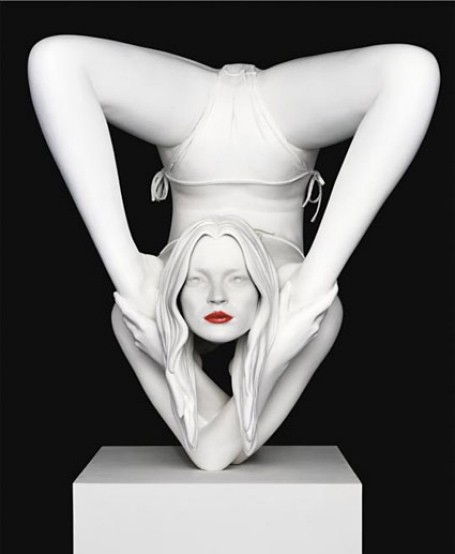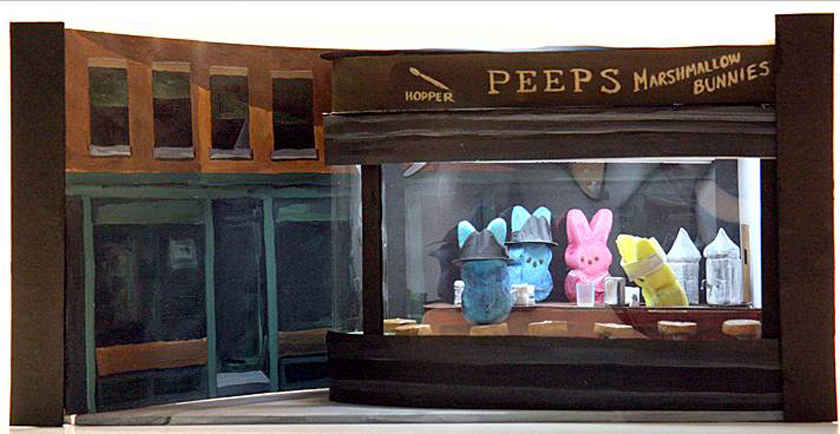
“An Oak Tree” Michael Craig-Martin, 1973
Conceptual art can be challenging and polarizing. Generally this is because the nature of conceptual art tends to be abstract, obscure, and elusive as the primary focus is the “idea” of the piece rather than any form or sense of aesthetic. There are very few guidelines and little to nothing available to prepare viewers for what to expect. The lack of definitive structure allows the viewer freedom to conceptualize and muse over the “idea” of the art piece, and while this can be liberating and exciting for one it can just as easily push away another who wants simply to enjoy something aesthetically pleasing.
So all of that babble was to pump you up for the the conceptual instillation An Oak Tree! An Oak Tree was created by Michael Craig-Martin and first displayed in 1973 in his own gallery. The original is in the National Gallery of Australia and an artist’s copy is on loan to the Tate gallery. The installation is comprised of two units arranged according to specific presentation guidelines: the object is a pristine French Duralex glass of water measured to the artist’s stipulation placed on a glass shelf fixed to the wall with metal brackets exactly 253 centimeters above the ground, also mounted on the wall is a text. The text appears in red on white paper, and upon its debut was dispensed as a handout. Craig-Martin has stressed that the components should maintain an immaculate appearance and in the event of deterioration the brackets should be resprayed and the glass and shelf replaced.
Now for the good stuff. The text makes the assertion through a semiotic argument that Craig-Martin was changed the glass of water into an oak tree by means of transubstantiation. He was able to do this without altering the “accidents” of the glass of water; and accidents are defined as color, weight, size, feel… etc so the “actual oak tree is physically present but in the form of the glass of water.” Craig-Martin asserts the impossible with that sentence, clarifying specifically that no, this is not symbolic of an oak tree but that a real oak tree is present, right in front of you, in the form of a glass of water.
“I have changed the physical substance of the glass of water into that of an oak tree. I didn’t change its appearance. The actual oak tree is physically present in the form of a glass of water. [And] it would no longer be accurate to call it a glass of water. One could call it anything one wished but that would not alter the fact that it is an oak tree.”
I am sure there are some of you wondering what is going on, why Craig-Martin would claim that he has transformed a glass of water into an oak tree and how this is art. First it is important to understand that transubstantiation is the same device that the Catholic Church uses during the Eucharist to transform bread and wine/juice into the body and blood of Christ when the worshipers take communion. They also assert the impossible and ask worshipers to believe the bread and wine become Christ’s body and blood during Eucharist while maintaining an unchanged appearance. In the same way Craig-Martin’s text asks the viewer to believe that the glass of water has become an oak tree without altering the “accidents” of a glass of water. One simply has to accept that the artist is right, relying on mutual belief between artist and viewer.
Secondly An Oak Tree deconstructs transubstantiation demonstrating that the belief of both artist and viewer has significant power over the formation of art, and in fact belief can be understood as the most basic and essential element of art. At least in this example of conceptual art. Craig-Martin considered the work of art to demonstrate the confident faith of the artist in his capacity to speak and the willing faith of the viewer in accepting what he has to say.
The reception of the piece was divided to say the least. Richard Cork called its original display in 1974 “one of the most challenging moments” of contemporary art. Some artists and critics were highly admirable while others where full of straight up scorn. I would read comments from Damien Hirst praising the piece as one of the greatest sculptures ever then shortly after find out that critic David Lee had ranted that “Some of the stuff that’s called art is just damned stupid. I mean, ‘That glass of water’s an oak tree’ kind of thing.”
More divisive opinions abound with critics criticizing each other’s opinions of the work as well. In response to Nigel Gosling’s praise of the work, Giles Auty sarcastically, though poignantly, observes, “How would the self-same critic react if, on ordering oak planks for an outhouse, he were sent instead a bucketful of water? Would he gently muse on ‘the subtle and obscure waters of identity’—or make immediate reflections on the mental well-being of his timber suppliers?” Michael Daley also condemns Craig-Martin’s admirers saying that they should have been snubbing the “self-deluding, pretentious offerings of Craig-Martin and his like” instead of “eulogising” them for the past twenty years.
In my opinion, I believe that the lasting effect an artwork has, what significant contributions the piece adds to the cannon of art history be it in the form of discord or admiration, adds to its importance over time. I don’t think anyone could say it better than Sir Nicholas Serota in his Richard Dimbleby Lecture on November 23:
“We may not ‘like’ Craig-Martin’s work, but it certainly reminds us that the appreciation of all art involves an act of faith comparable [to belief].”
You have to understand that An Oak Tree was one of the first of its kind. It laid a foundation for later conceptual artists to build upon. We knew that art could take many forms thanks to the modernism and Dada, but Crag-Martin demonstrated that art can be created from abstract ideas, faith held between two believers. And An Oak Tree only works if a mutual belief is shared between viewer and artist. In this sense it is almost an intimate understanding, a mutual agreement almost like a shared secret or religious bond.
Both the Irish Museum of Modern Art and Stanford Encyclopedia of Philosophy praise the piece, recognizing it as a turning point in the development of conceptual art. The Stanford Encyclopedia of Philosophy records acclaim such as “to fail to consider it a great work of art because it fails to give rise to a distinctively aesthetic kind of pleasure does not actually undermine the project at all. Conceptual art, as we now know, is about conveying meaning through a vehicular medium, and not to provide its audience with experiences of, say, beauty. Any attack on this fundamental feature of conceptual art targets not so much an individual piece but the artform as such.”
So what I hope to persuade you with this post is that yes, I get it, conceptual art is not for everyone. But having said that, I think it is important for everyone to recognize when something is significant to a larger social and historical context whether they like it or not. Liking art is arbitrary to the influence it held during its time and continues to hold ever after.
Here’s the text so you may read it:
Q. To begin with, could you describe this work?
A. Yes, of course. What I’ve done is change a glass of water into a full-grown oak tree without altering the accidents of the glass of water.
Q. The accidents?
A. Yes. The colour, feel, weight, size …
Q. Do you mean that the glass of water is a symbol of an oak tree?
A. No. It’s not a symbol. I’ve changed the physical substance of the glass of water into that of an oak tree.
Q. It looks like a glass of water.
A. Of course it does. I didn’t change its appearance. But it’s not a glass of water, it’s an oak tree.
Q. Can you prove what you’ve claimed to have done?
A. Well, yes and no. I claim to have maintained the physical form of the glass of water and, as you can see, I have. However, as one normally looks for evidence of physical change in terms of altered form, no such proof exists.
Q. Haven’t you simply called this glass of water an oak tree?
A. Absolutely not. It is not a glass of water anymore. I have changed its actual substance. It would no longer be accurate to call it a glass of water. One could call it anything one wished but that would not alter the fact that it is an oak tree.
Q. Isn’t this just a case of the emperor’s new clothes?
A. No. With the emperor’s new clothes people claimed to see something that wasn’t there because they felt they should. I would be very surprised if anyone told me they saw an oak tree.
Q. Was it difficult to effect the change?
A. No effort at all. But it took me years of work before I realised I could do it.
Q. When precisely did the glass of water become an oak tree?
A. When I put the water in the glass.
Q. Does this happen every time you fill a glass with water?
A. No, of course not. Only when I intend to change it into an oak tree.
Q. Then intention causes the change?
A. I would say it precipitates the change.
Q. You don’t know how you do it?
A. It contradicts what I feel I know about cause and effect.
Q. It seems to me that you are claiming to have worked a miracle. Isn’t that the case?
A. I’m flattered that you think so.
Q. But aren’t you the only person who can do something like this?
A. How could I know?
Q. Could you teach others to do it?
A. No, it’s not something one can teach.
Q. Do you consider that changing the glass of water into an oak tree constitutes an art work?
A. Yes.
Q. What precisely is the art work? The glass of water?
A. There is no glass of water anymore.
Q. The process of change?
A. There is no process involved in the change.
Q. The oak tree?
A. Yes. The oak tree.
Q. But the oak tree only exists in the mind.
A. No. The actual oak tree is physically present but in the form of the glass of water. As the glass of water was a particular glass of water, the oak tree is also a particular oak tree. To conceive the category ‘oak tree’ or to picture a particular oak tree is not to understand and experience what appears to be a glass of water as an oak tree. Just as it is imperceivable it also inconceivable.
Q. Did the particular oak tree exist somewhere else before it took the form of a glass of water?
A. No. This particular oak tree did not exist previously. I should also point out that it does not and will not ever have any other form than that of a glass of water.
Q. How long will it continue to be an oak tree?
A. Until I change it







-uk-640x537.jpg)





















































